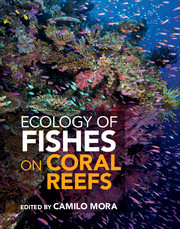Book contents
- Frontmatter
- Contents
- Preface
- Foreword
- List of contributors
- PART I BASIC ECOLOGY
- 1 Sensory biology and navigation behavior of reef fish larvae
- 2 Mission impossible: unlocking the secrets of coral reef fish dispersal
- 3 Recruitment of coral reef fishes: linkages across stages
- 4 Competition in reef fishes
- 5 Predation: piscivory and the ecology of coral reef fishes
- PART II PATTERNS AND PROCESSES
- PART III HUMAN FINGERPRINTS
- PART IV CONSERVATION
- PART V DEBATES AND PARADIGM SHIFTS
- References
- Index
1 - Sensory biology and navigation behavior of reef fish larvae
from PART I - BASIC ECOLOGY
Published online by Cambridge University Press: 05 May 2015
- Frontmatter
- Contents
- Preface
- Foreword
- List of contributors
- PART I BASIC ECOLOGY
- 1 Sensory biology and navigation behavior of reef fish larvae
- 2 Mission impossible: unlocking the secrets of coral reef fish dispersal
- 3 Recruitment of coral reef fishes: linkages across stages
- 4 Competition in reef fishes
- 5 Predation: piscivory and the ecology of coral reef fishes
- PART II PATTERNS AND PROCESSES
- PART III HUMAN FINGERPRINTS
- PART IV CONSERVATION
- PART V DEBATES AND PARADIGM SHIFTS
- References
- Index
Summary
Spurred by the still accelerating progress made in the last decade(s) in our knowledge of the behavioral capabilities of coral reef fish larvae, we review their sensory world and its potential for orientation and homing navigation. We now know that these millimeter-sized animals have swimming and sensing capabilities that could influence their advective dispersal. During the pelagic phase, sustained swimming capabilities increase to speeds exceeding prevailing currents and senses develop that could steer them. After hatching, the nose develops from bilateral sensory patches to an active odor-sampling organ that recognizes habitat and social odors, some apparently learned at the hatching stage. As larvae grow, vision improves from light detection to image formation: the eye and lens grow proportionally and the retina becomes steadily more organized resulting in greater acuity and possibly allowing UV and polarized light detection. Growth of the vestibular apparatus, including the otoliths, should enhance hearing, while a swim bladder, present in some species even prior to hatching, should further increase hearing sensitivity and higher frequency detection. The brain shows its major subdivisions well before hatching and continues to grow rapidly. Behavioral experiments suggest that this brain can extract and store environmental information that can be used in orientation, navigation, and settlement. Here, we discuss the ontogeny of swimming behavior and the multi-sensory control that may be involved in orientation and navigation. The evidence is based on anatomical and behavioral studies of larvae and on the physical dispersal patterns and detection distances of sensory stimuli. However, obtaining pelagic-phase experimental data from these widely dispersed, “invisible” propagules is exceedingly difficult. We emphasize the essential role of learning and present a behavioral hypothesis of homing navigation. Much remains to be learned to improve the accuracy of dispersal models in capturing larval behavior and predicting recruitment patterns needed for management of sustainable populations and their habitat in a time of global change.
- Type
- Chapter
- Information
- Ecology of Fishes on Coral Reefs , pp. 3 - 15Publisher: Cambridge University PressPrint publication year: 2015
- 9
- Cited by



